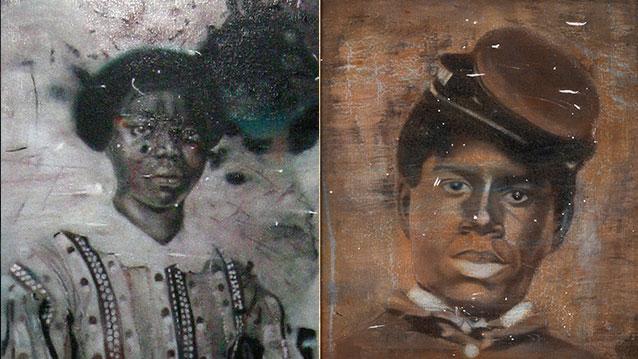EVANSTON, Ill. --- A collection of stylized portraits that are meant to convey the hope, potential freedom and happiness many former slaves and freed black citizens envisioned after the Civil War will be featured at Northwestern University this spring.
Created by downstate Illinois “history painter” and guest artist Jason Patterson, the portraits capture the artist’s vision of an idealized history and are not meant to tell a comprehensive history.
Patterson’s solo exhibition, “New Americans: Our Mutual Improvement and Social Elevation,” April 4 through May 11, will be presented at the University’s Dittmar Memorial Gallery, on the first floor of Norris University Center, 1999 Campus Drive, Evanston campus.
The exhibition, an opening reception from 6 to 8 p.m. Friday, April 4, and a “Talk Back With Artist Jason Patterson,” from 6 to 8 p.m. Tuesday, April 29, co-sponsored by For Members Only, the University’s black student alliance, are free and open to the public.
Patterson’s portraits are a contemporary examination of images rendered after mid- to late- 19tth-century tintypes, daguerreotypes and ambrotypes. It was a period that followed the Emancipation Proclamation, the passages of the 13th, 14th and 15th Amendments (also known as the “Reconstruction Amendments”) and the end of the American Civil War.
“That period for African-Americans was post-Civil War, but pre-Jim Crow, and before the cultural economic, moral and legal oppression of Afro-Americans was solidly institutionalized,” Patterson said.
It took four years for Patterson to gather source images for the artworks featured in the Dittmar’s exhibit.
One of the show’s highlights is a three-quarter-length portrait Patterson completed in 2012 of an unidentified and prosperous looking young black woman, who is seated and wearing a fashionable floral-striped, long-sleeved summer dress. This rendering is based on a circa 1860 ambrotype in the Yale University Beinecke Library’s Randolph Linsly Simpson collection, one of the main resources for many of Patterson’s works. Others were inspired by vintage photographs from the Library of Congress archives, old newspaper clippings, Google searches or YouTube video stills.
His creative process includes using heavily spray-fixed chalk pastel on raw canvas, a technique he says would be best described as drawing. Most of the portraits are life-size with altered or added splashes of color. They will be displayed in stylized wood frames that Patterson built himself and patterned after 19th-century designs, a finishing touch he considers as important as the artistic renderings they surround.
“The work I make is not solely meant to represent the image being depicted,” said the artist, who lives and works in Urbana. “It is also meant to represent the image’s original format.”
For more information, contact the Dittmar Gallery at (847) 491-2348 or Norris University Center at (847) 491-2300, email dittmargallery@northwestern.edu or visit www.dittmar.northwestern.edu.


